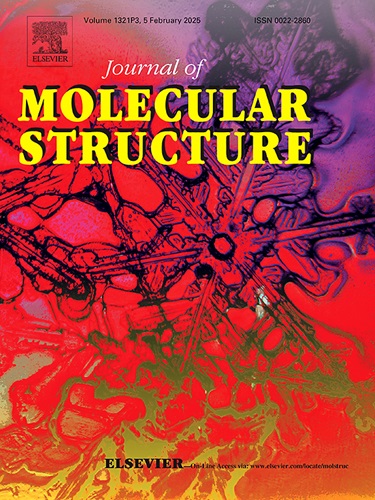Synthesis, spectral characterisation, and biological studies of N,N’-Bis(4-isopropylbenzylidene)-2,3-diaminopyridene and their metal complexes
IF 4
2区 化学
Q2 CHEMISTRY, PHYSICAL
引用次数: 0
Abstract
The present study involves the synthesis of N,N’-bis(4-Isopropylbenzylidene)-2,3-diaminopyridene and its cobalt(II), nickel(II), and copper(II) complexes and investigating their biological activity against a selected cancer cell. The presence of the imine group in the Schiff base ligands have been the cause of various biological activities, which upon coordination with transition metals may further enhance the activity. In this regard, we have synthesized few transition metal complexes containing Schiff base ligand to investigate their biological activity. All the synthesized compounds were characterized by various spectral and analytical techniques. The complexes were characterized on the basis of metal estimation studies, conductance behaviour, magnetic property, IR, UV-Vis, EPR (liquid nitrogen temperature) spectral studies, and thermal analysis. The metal ions and ligands are maintained at 1:2 ratio in the synthesized complexes. Various studies have indicated that the Co(II) complex likely adopts an octahedral geometry, while a square planar geometry is proposed for both the Cu(II) (distorted) and Ni(II) complexes. The electrochemical properties of the complexes were studied by cyclic voltammetry. The Schiff base and its complexes were scrutinized against bacterial and fungal pathogens. The cobalt and copper complexes show the maximum activity towards the bacterial pathogen S. aureus; therefore, they were further scrutinized for minimum inhibitory concentration studies. The copper complex is found to have moderate cytotoxicity against the breast cancer cell line (MCF-7).
N,N ' -双(4-异丙基苄基)-2,3-二氨基吡啶及其金属配合物的合成、光谱表征和生物学研究
本研究涉及合成N,N ' -双(4-异丙基苄基)-2,3-二氨基吡啶及其钴(II)、镍(II)和铜(II)配合物,并研究它们对选定癌细胞的生物活性。希夫碱配体中亚胺基的存在是各种生物活性的原因,与过渡金属配合可以进一步增强活性。在这方面,我们已经合成了一些含有席夫碱配体的过渡金属配合物来研究它们的生物活性。所有合成的化合物都通过各种光谱和分析技术进行了表征。通过金属估计、电导行为、磁性、IR、UV-Vis、EPR(液氮温度)光谱研究和热分析对配合物进行了表征。在所合成的配合物中,金属离子与配体保持1:2的比例。各种研究表明,Co(II)配合物可能采用八面体几何形状,而Cu(II)(扭曲)和Ni(II)配合物则可能采用方形平面几何形状。用循环伏安法研究了配合物的电化学性质。研究了希夫碱及其配合物对细菌和真菌病原体的抑制作用。钴和铜配合物对金黄色葡萄球菌的活性最大;因此,他们进一步审查最低抑菌浓度的研究。铜复合物被发现对乳腺癌细胞系(MCF-7)具有中等的细胞毒性。
本文章由计算机程序翻译,如有差异,请以英文原文为准。
求助全文
约1分钟内获得全文
求助全文
来源期刊

Journal of Molecular Structure
化学-物理化学
CiteScore
7.10
自引率
15.80%
发文量
2384
审稿时长
45 days
期刊介绍:
The Journal of Molecular Structure is dedicated to the publication of full-length articles and review papers, providing important new structural information on all types of chemical species including:
• Stable and unstable molecules in all types of environments (vapour, molecular beam, liquid, solution, liquid crystal, solid state, matrix-isolated, surface-absorbed etc.)
• Chemical intermediates
• Molecules in excited states
• Biological molecules
• Polymers.
The methods used may include any combination of spectroscopic and non-spectroscopic techniques, for example:
• Infrared spectroscopy (mid, far, near)
• Raman spectroscopy and non-linear Raman methods (CARS, etc.)
• Electronic absorption spectroscopy
• Optical rotatory dispersion and circular dichroism
• Fluorescence and phosphorescence techniques
• Electron spectroscopies (PES, XPS), EXAFS, etc.
• Microwave spectroscopy
• Electron diffraction
• NMR and ESR spectroscopies
• Mössbauer spectroscopy
• X-ray crystallography
• Charge Density Analyses
• Computational Studies (supplementing experimental methods)
We encourage publications combining theoretical and experimental approaches. The structural insights gained by the studies should be correlated with the properties, activity and/ or reactivity of the molecule under investigation and the relevance of this molecule and its implications should be discussed.
 求助内容:
求助内容: 应助结果提醒方式:
应助结果提醒方式:


